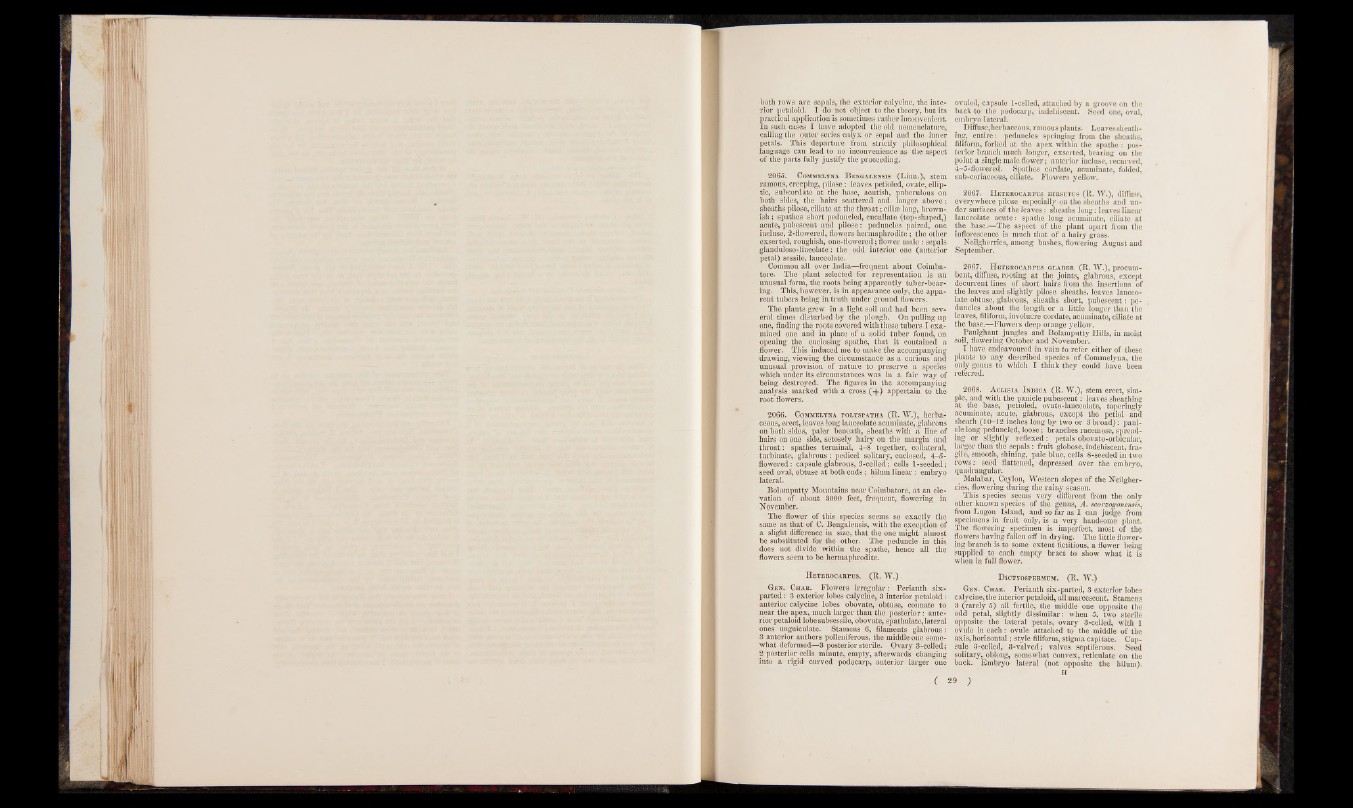
both rows are sepals, the exterior calycine, the interior
petaloid. I do not object to the theory, but its
practical application is sometimes rather inconvenient.
In such cases I have adopted the old nomenclature,
calling the outer series calyx or sepal and the inner
petals. This departure from strictly philosophical
language can lead to no inconvenience as the aspect
of the parts fully justify the proceeding.
2065. Commelyna B engalensis (Linn.), stem
raraous, creeping, pilose : leaves petioled, ovate, elliptic,
subcordate at the base, acutish, puberulous on
both sides, the hairs scattered and longer above;
sheaths pilose, ciliate at the th ro at; cilia} long, brownish
; spathes short peduncled, cucullate (top-shaped,)
acute, pubescent and pilose: peduncles paired, one
incluse, 2-flowered, flowers hermaphrodite; the other
exserted, roughish, one-flowered; flower male: sepals
glanduloso-lineolate: the _ odd interior one (anterior
petal) sessile, lanceolate.
Common all over India—frequent about Coimbatore.
The plant selected- for representation is an
unusual form, the roots being apparently tuber-bearing.
This, however, is in appearance only, the apparent
tubers being in truth under ground flowers.
The plants grew in a light soil and had been several
times disturbed by the plough. On pulling up
one, finding the roots covered with these tubers I examined
one and in place of a solid tuber found, on
opening the enclosing spathe, that it contained a
flower. This induced me to make the accompanying
drawing, viewing the circumstance as a curious and
unusual provision of nature to preserve a species
which under its circumstances was in a fair way of
being destroyed. The figures in the accompanying
analysis marked with a cross (+ ) appertain to the
root flowers.
2066. Commelyna polyspatha (R. W.), herba-
ceous, erect, leaves long lanceolate acuminate, glabrous
on both sides, paler beneath, sheaths with a line of
hairs on one side, setosely hairy on the margin and
th ro at: spathes terminal, 4-8 together, collateral,
turbinate, glabrous: pedicel solitary, enclosed, 4-5-
flowered: capsule glabrous, 3-celled; cells 1-seeded;
seed oval, obtuse at both ends; hilum linear: embryo
lateral.
Bolamputty Mountains near Coimbatore, at an elevation
of about 8000 feet, frequent, flowering in
November.
The flower of this species seems so exactly the
same as that of C. Bengalensis, with the exception of
a slight difference in size, that the one might almost
be substituted for the other. The peduncle in this
does not divide within the spathe, hence all the
flowers seem to be hermaphrodite.
ovuled, capsule 1 -celled, attached by a groove on the
back to the podocarp, indéhiscent. Seed one, oval,
embryo lateral.
Diffuse, herbaceous, ramous plants. Leaves sheathing,
entire : peduncles springing from the sheaths,
filiform, forked at the apex within the spathe : posterior
branch much longer, exserted, bearing on the
point a single male flower ; anterior incluse, recurved,
4-5-flowered. Spathes cordate, acuminate, folded,
sub-coriaceous, ciliate. Flowers yellow.
2067. Heterocarpus hirsutus (R. W.), diffuse,
everywhere pilose especially on the sheaths and under
surfaces of the leaves : sheaths long : leaves linear
lanceolate acute: spathe long acuminate, Ciliate at
the base.—The aspect of the plant apart from the
inflorescence is much that of a hairy grass.
Neilghcrries, among bushes, flowering August and
September.
2067. H eterocarpus glabbr (R. W.), procumbent,
diffuse, rooting at the joints, glabrous, except
decurrent lines of short hairs from the insertions of
the leaves and slightly pilose sheaths, leaves lanceolate
obtuse, glabrous, sheaths short, pubescent : peduncles
about the length or a little longer than the
leaves, filiform, involucre cordate, acuminate, ciliate at
the base.—Flowers deep orange yellow.
Paulghaut jungles and Bolamputty Hills, in moist
soil, flowering October and November.
I have endeavoured in vain to refer either of these
plants to any described species of Commelyna, the
only genus to which I think they could have been
referred.
2068. Acmsia I ndica (R. W.), stem erect, simple,
and with the panicle pubescent : leaves sheathing
a t the base, petioled, ovato-lanceolate, taperingly
acuminate, acute, glabrous, except the petiol and
sheath ( 10 -12 inches long by two or 3 broad) : panicle
long peduncled, loose ; branches racemose, spreading
or slightly reflexed : petals obovato-orbicular,
larger than the sepals : fruit globose, indéhiscent, fragile,
smooth, shining, pale blue, cells 8-seeded in two
rows: seed flattened, depressed over the embryo,
quadrangular.
Malabar^ Ceylon, Western slopes of the Neilgher-
ries, flowering during the rainy season.
This species seems very different from the only
other known species of the genus, A. scorzôgonensis,
from Lugon Island, and so for as I can judge from
specimens in fruit only, is a very handsome plant.
The flowering specimen is imperfect, most of the
flowers having fallen off in drying. The little flowering
branch is to some extent fictitious, a flower being
supplied to each empty bract to show what it is
when in full flower.
H eterocarpus. (R. W.)
Gen. Char. Flowers irregular: Perianth six-
parted : 3 exterior lobes calycine, 3 interior petaloid:
anterior calycine lobes obovate, obtuse, connate to
near the apex, much larger than the posterior: anterior
petaloid lobesubsessile, obovate, spathulate, lateral
ones unguiculate. Stamens 6, filaments glabrous:
3 anterior anthers polleniferous, the middle one somewhat
deformed—3 posterior sterile. Ovary 3-celled;
2 posterior cells minute, empty, afterwards changing
into a rigid curved podocarp, anterior larger one
D ictyospermum. (R. W.)
Gen. Char. Perianth six-parted, 3 exterior lobes
calycine, the interior petaloid, all marcescent. Stamens
3 (rarely 5) all fertile, the middle one opposite the
odd petal, slightly dissimilar: when 5, two sterile
opposite the lateral petals, ovary 3-celled, with 1
ovule in each: ovule attached to the middle of the
axis, horizontal; style filiform, stigma capitate. Capsule
3-celled, 3-valved; valves septiferous. Seed
solitary, oblong, somewhat convex, reticulate on the
back. Embryo lateral (not opposite the hilum).
H